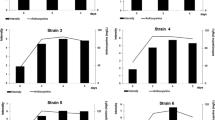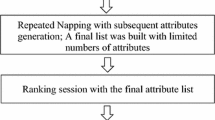Abstract
The aim of this research was to study the behaviour of 70 different Saccharomyces cerevisiae strains on the antioxidant compounds level in wines by RP-HPLC/DAD. Micro-winemaking was carried out in Cabernet Sauvignon grape must testing eight Italian wild strains, 12 derived monosporal cultures, 15 hybrids obtained by monosporal spore-to-spore conjugation, 34 monosporal cultures derived from the hybrids, and Zymaflore F15 as control strain. At the end of the winemaking, the wines show significant differences concerning their antioxidant levels in relation to the strain used. Catechin and epicatechin were the principal antioxidant compounds for all the samples. In particular, the catechin content varied from 0 to 79.53 mg/L, while epicatechin varied from 0 to 70.51 mg/L. The vanillic acid level varied from 3.10 to 12.71 mg/L. Gallic and caffeic acids varied, respectively, from 2.54 to 6.77 mg/L and from 0 to 10.63 mg/L. The rutin and quercetin content varied from 0 to 11.77 mg/L and from 0 to 2.09 mg/L, while trans-resveratrol level varied from 0 to 0.85 mg/L. Data validate the main role that wine yeast selection plays to enhance red wine content in antioxidant phenolic compounds.

Similar content being viewed by others
References
Cimino F, Sulfaro V, Trombetta D, Saija A, Tomaino A (2007) Radical scavenging capacity of several Italian red wines. Food Chem 103:75–81
Atanacković M, Petrović A, Jović S, Gojković-Bukarica L, Bursać M, Cvejić J (2012) Influence of winemaking techniques on the resveratrol content, total phenolic content and antioxidant potential of red wines. Food Chem 131:513–518
Frémont L (2000) Biological effects of resveratrol. Life Sci 66:663–673
Agrawal P, Halaweish F, Dwivedi C (2007) Antioxidant effects and drug interactions of resveratrol present in wine. J Wine Res 8:59–71
Dawn B (2006) Resveratrol: ready for prime time? J Mol Cell Cardiol 42:484–486
Goswami SK, Das DK (2009) Resveratrol and chemoprevention. Cancer Lett 284:1–6
Szkudelska K, Szkudelski T (2010) Resveratrol, obesity and diabetes. Eur J Pharmacol 635:1–8
Roggero J-P, Archier P (1994) Quantitative determination of resveratrol and of one of its glycosides in wines. Sci Aliment 14:99–107
Kolouchová-Hanzlíková I, Melzoch K, Fili V, Smidrkal J (2004) Rapid method for resveratrol determination by HPLC with electrochemical and UV detections in wines. Food Chem 87:151–158
Montsko G, Ohmacht R, Mark L (2010) Trans-resveratrol and trans-piceid content of Hungarian wines. Chromat 71:121–124
Giuffrè A M (2013) High performance liquid chromatography-diode array detector (HPLC-DAD) detection of trans-resveratrol: evolution during ripening in grape berry skins. Afr J Agr Res 8:224–229
Jeandet P, Bessis R, Maume BF, Meunier P, Peyron D, Trollat P (1995) Effect of oenological practices on the resveratrol isomer content of wine. J Agric Food Chem 43:316–319
Wang Y, Halls C, Zhang J, Matsuno M, Zhang Y, Yu O (2011) Stepwise increase of resveratrol biosynthesis in yeast Saccharomyces cerevisiae by metabolic engineering. Metab Eng 13:455–463
Gao J, Xi Z, Zhang J, Guo Z, Chen T, Fang Y (2012) Influence of fermentation method on phenolics, antioxidant capacity and volatiles in blackberry wines. Anal Lett 17:2603–2622
Coletta A, Berto S, Crupi P, Cravero MC, Tamborra P, Antonacci D (2014) Effect of viticulture practices on concentration of polyphenolic compounds and total antioxidant capacity of Southern Italy red wines. Food Chem 152:467–474
Orser RE, Yang HY (1966) Gas–liquid chromatographic analysis of blackberry wine extracts fermented by different yeast strains. Am J Enol Viticult 2:106–111
Hernández LF, Espinosa J-C, Fernández-González M, Briones A (2003) ß-glucosidase activity in a Saccharomyces cerevisiae wine strain. Int J Food Microbiol 80:171–176
Morata A, Gómez-Cordovés MC, Colomo B, Suárez JA (2003) Pyruvic acid and acetaldehyde production by different strains of Saccharomyces cerevisiae: relationship with Visitin A and B formation in red wines. J Agric Food Chem 51:7402–7409
Loira I, Vejarano R, Morata A, Ricardo-da-Silva JM, Laureano O, González MC (2013) Effect of Saccharomyces strains on the quality of red wines aged on lees. Food Chem 139:1044–1051
Morata A, Gómez-Cordovés MC, Colomo B, Suárez JA (2005) Cell wall anthocyanin adsorption by different Saccharomyces strains during the fermentation of Vitis vinifera L. cv. Graciano grapes. Eur Food Res Technol 220:341–346
Caridi A (2006) Enological functions of parietal yeast mannoproteins. Anton Leeuw Int J G 89:417–422
Salmon JM (2006) Interactions between yeast, oxygen and polyphenols during alcoholic fermentations: practical implications. LWT-Food Sci Technol 39:959–965
Caridi A, Sidari R, Solieri L, Cufari A, Giudici P (2007) Wine colour adsorption phenotype: an inheritable quantitative trait loci of yeasts. J Appl Microbiol 103:735–742
Caridi A, Cufari A, Lovino R, Palumbo R, Tedesco I (2004) Influence of yeast on polyphenol composition of wine. Food Technol. Biotech 42:37–40
Sidari R, Postorino S, Caparello A, Caridi A (2007) Evolution during wine aging of colour and tannin differences induced by wine starters. Ann Microbiol 57:197–201
Ivanova-Petropulos V, Ricci A, Nedelkovski D, Dimovska V, Parpinello GP, Versari A (2015) Targeted analysis of bioactive phenolic compounds and antioxidant activity of Macedonian red wines. Food Chem 171:412–420
Caridi A (2013) Improved screening method for the selection of wine yeasts based on their pigment adsorption activity. Food Technol Biotech 51:137–144
Caridi A, Sidari R, Kraková L, Kuchta T, Pangallo D (2015) Assessment of color adsorption by yeast using Grape Skin agar and impact on red wine color. J Int Sci Vigne Vin 49:195–203
Sidari R, Caridi A, Howell KS (2014) Wild Saccharomyces cerevisiae strains display biofilm-like morphology in contact with polyphenols from grapes and wine. Int J Food Microbiol 189:146–152
Sidari R, Caridi A (2016) Nutrient depletion modifies cell wall adsorption activity of wine yeast. World J Microb Biot 32:1–7
Del Barrio-Galán R, Medel-Marabolí M, Peña-Neira A (2015) Effect of different aging techniques on the polysaccharide and phenolic composition and sensorial characteristics of Syrah red wines fermented using different yeast strains. Food Chem 179:116–126
Del Barrio-Galán R, Cáceres-Mella A, Medel-Marabolí M, Peña-Neira A (2015) Effect of selected Saccharomyces cerevisiae yeast strains and different aging techniques on the polysaccharide and polyphenolic composition and sensorial characteristics of Cabernet Sauvignon red wines. J Sci Food Agr 95:2132–2144
Domizio P, Liu Y, Bisson LF, Barile D (2017) Cell wall polysaccharides released during the alcoholic fermentation by Schizosaccharomyces pombe and S. japonicus: quantification and characterization. Food Microbiol 61:136–149
Mekoue Nguela J, Vernhet A, Sieczkowski N, Brillouet JM (2015) Interactions of condensed tannins with Saccharomyces cerevisiae yeast cells and cell walls: tannin location by microscopy. J Agric Food Chem 63:7539–7545
Mekoue Nguela J, Sieczkowski N, Roi S, Vernhet A (2015) Sorption of grape proanthocyanidins and wine polyphenols by yeasts, inactivated yeasts, and yeast cell walls. J Agric Food Chem 63:660–670
Degree R. Killer yeasts (1993) In: Fleet GH (ed) Wine microbiology and biotechnology. Harwood Academic Publishers, Chur, pp 243–264
Zironi R, Romano P, Suzzi G, Battistutta F, Comi G (1993) Volatile metabolites produced in wine by mixed and sequential cultures of Hanseniaspora guilliermondii or Kloeckera apiculata and Saccharomyces cerevisiae. Biotechnol Lett 3:235–238
Ciani M, Picciotti G (1995) The growth kinetics and fermentation behaviour of some non-Saccharomyces yeasts associated with winemaking. Biotechnol Lett 17:1247–1250
Petravić-Tominac V, Mesihović A, Mujadžić S, Lisičar J, Oros D, Velić D, et al (2013) Production of blackberry wine by microfermentation using commercial yeasts Fermol Rouge® and Fermol Mediterranée. Agric Conspec Sci 78:49–55
González-Candelas R, Gil JV, Lamuela-Raventó RM, Ramón D (2000) The use of transgenic yeasts expressing a gene encoding a glycosyl-hydrolase as a tool to increase resveratrol content in wine. Int J Food Microbiol 59:179–183
Becker JVW, Armstrong GO, Van der Merwe MJ, Lambrechts MG, Vivier MA, Pretorius IS (2003) Metabolic engineering of Saccharomyces cerevisiae for the synthesis of the wine-related antioxidant resveratrol. FEMS Yeast Res 4:79–85
Directive 2001 18/EC of the European Parliament and of the Council of 12 March 2001 on the Deliberate Release into the Environment of Genetically Modified Organisms and Repealing Council Directive, supra note 1, art. 2 (3).
Thornton RJ, Eschenbruch R (1976) Homothallism in wine yeasts. Anton Leeuw 42:503–509
Zambonelli C (1998) Microbiology and wine biotechnology. Edagricole, Bologna
Boveri S, Rainieri S, Pulvirenti A (2012) Method for the validation of intraspecific crosses of Saccharomyces cerevisiae strains by minisatellite analysis. Can J Microbiol 58:350–358
Caridi A, De Bruno A, Piscopo A, Poiana M, Sidari R (2015) Study of the inheritability of the yeast trait “interaction with natural antioxidant activity of red wine” in four generations of Saccharomyces cerevisiae and its enhancing by spore clone selection and hybridization. Eur Food Res Technol 240:1059–1063
Di Stefano R, Cravero MC (1992) The separation of hydroxycinnamates in wine. Sci Aliment 12:139–144
Giuffrè AM (2013) HPLC-DAD detection of changes in phenol content of red berry skins during grape ripening. Eur Food Res Technol 237:555–564
Fowell RR (1952) Sodium acetate agar as a sporulation medium for yeasts. Nature 170:578
La Torre GL, Saitta M, Vilasi F, Pellicanò T, Dugo G (2006) Direct determination of phenolic compounds in Sicilian wines by liquid chromatography with PDA and MS detection. Food Chem 94:640–650
Luchian CE, Cotea VV, Colibaba LC, Zamfir C, Codreanu M, Niculaua M, et al (2015) Influence of nanoporous materials on the chemical composition of Merlot and Cabernet Sauvignon wines. Environ Eng Manag J 14:519–524
Del Barrio-Galán R, Pérez-Magariño S, Ortega-Heras M (2011) Techniques for improving or replacing ageing on lees of oak aged red wines: the effects on polysaccharides and the phenolic composition. Food Chem 127:528–540
Del Barrio-Galán R, Pérez-Magariño S, Ortega-Heras M (2012) Effect of the aging on lees and other alternative techniques on the low molecular weight phenols of Tempranillo red wine aged in oak barrels. Anal Chim Acta 732:53–63
Odani T, Shimma Y, Wang X (1997) Mannosylphosphate transfer to cell wall mannan is regulated by the transcriptional level of the MNN4 gene in Saccharomyces cerevisiae. FEBS Lett 420:186–190
Acknowledgements
This research was supported by POR CALABRIA FESR 2007/2013—ASSE I—Obiettivo Specifico 1.1—Obiettivo Operativo 1.1.1—Linea di Intervento 1.1.1.2 Innovazione di processo e nuovi prodotti per la valorizzazione dei vini e passiti da cv autoctone—ENOTRIA TELLUS.
Author information
Authors and Affiliations
Corresponding author
Ethics declarations
Conflict of interest
None.
Compliance with ethics requirements
This article does not contain any studies with human or animal subjects.
Rights and permissions
About this article
Cite this article
Caridi, A., Sidari, R., Giuffrè, A.M. et al. Test of four generations of Saccharomyces cerevisiae concerning their effect on antioxidant phenolic compounds in wine. Eur Food Res Technol 243, 1287–1294 (2017). https://doi.org/10.1007/s00217-016-2840-8
Received:
Revised:
Accepted:
Published:
Issue Date:
DOI: https://doi.org/10.1007/s00217-016-2840-8




